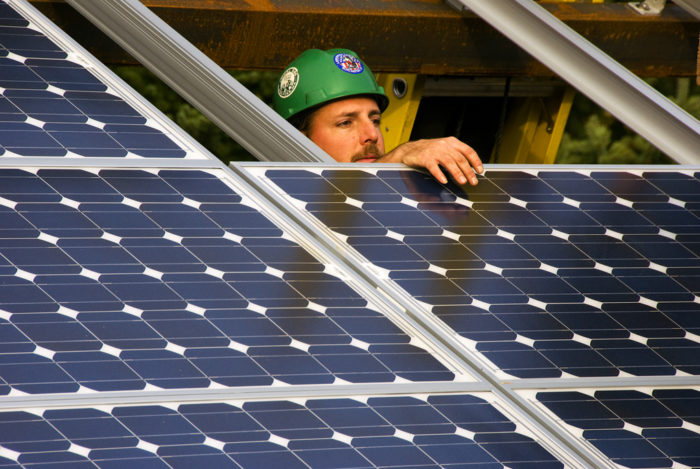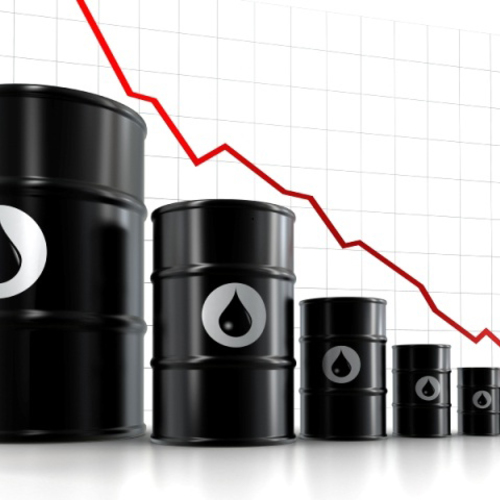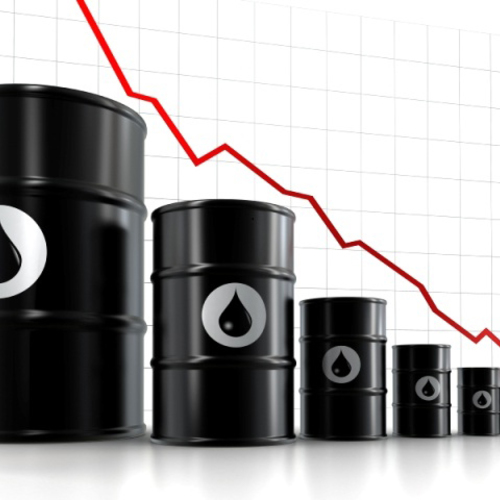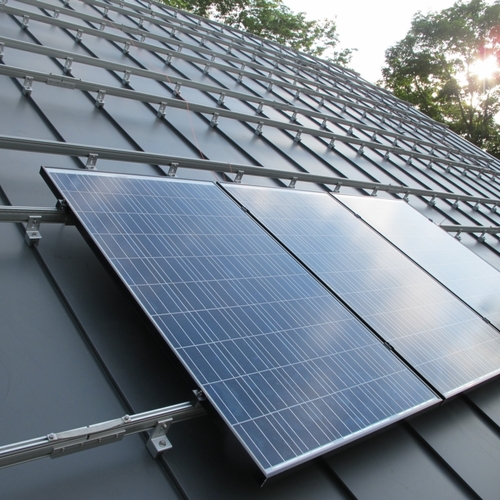
Image Credit: Oregon DOT
Until now, Patrick McCombe has believed that improvements to the envelope of his home should come before an investment in photovoltaic panels. Now he’s weighing a deal that seems too good to pass up.
McCombe lives in Connecticut (he’s an associate editor at Fine Homebuilding magazine) and he recently attended an informational meeting sponsored by an organization working to lower the cost of PV. Panels could be purchased or leased, but the bottom line was that with federal and state incentives, McCombe could buy a 10-kilowatt array for $15,000.
“I’ve always believed that envelope improvements make more sense than PV,” he writes in a Q&A post at GreenBuildingAdvisor, “but the state and federal incentives and super low prices of PV coupled with our very high electric rates has me considering an installation.”
McCombe heats his small house with fuel oil, a relatively expensive fuel common to New England. Even though he doesn’t use that much oil, the prospect of weaning himself from this fuel entirely is very attractive.
“Am I silly for installing PV first without significant envelope improvements to my very small but not terribly efficient home?” he asks. “In the three years we’ve lived there we’ve needed three tanks of heating oil, so our heating costs are much lower than most folks in New England. Our house is small and reasonably airtight. If we lowered our plug loads, it’s conceivable we could also heat our house with heat pumps or resistance heaters using our 10 kW array.”
As the installed cost of solar electric continues to fall and subsidies remain in place, this is a choice many other homeowners could be facing. That’s the topic for this Q&A Spotlight.
That’s too good of a deal to pass up
Weekly Newsletter
Get building science and energy efficiency advice, plus special offers, in your inbox.

This article is only available to GBA Prime Members
Sign up for a free trial and get instant access to this article as well as GBA’s complete library of premium articles and construction details.
Start Free TrialAlready a member? Log in















11 Comments
Great blog
Logic verses passion verses what may change if we all change... we all sometimes focus on one point while not taking in the reaction forces.
Thanks for the blog
aj
Things can change faster than you think...
Peter Yost's buddy Mark Sevier commented:
"In Massachusetts, regulators specifically changed the net metering structure in 2010 to help get more renewables in place faster, so I don't see this being reversed anytime soon in states where there is a push to add renewable generation."
With MA residential retail electricity rates being already well ahead of the lifecycle cost of PV, and third-party ownership/financing making it easy for homeowners to get in for effectively zero cash, as PV keeps getting cheaper, with a widening margin the installation rates are likely to grow exponentially, as has happened in Hawaii. Hawaii's power rates are about 2x that of Massachusetts across the board, which is quite a driver. Oahu is now hitting horth of 10% share of PV for all kwh shipped across the grid more than 100% output on on some circuits leading to back-feeding on circuits not designed for managing this much load, and now there are grid-upgrade fees applied to new installations on the saturated circuits, but still no end in sight on the exponential growth (albeit a change in exponent, for now).
By 2020 the costs of PV relative to the residential rates in MA will be comparable to what's currently going on in Hawaii. Unless most of the infrastructure for managing the explosive growth in MA at that point is already in place, there will be a similar crisis point where something has to give, and quickly. If a third party company can cut a power purchasing deal with the homeowner for 10 cents/kwh in a 16 cent kwh climate and still make huge money, that 10% grid share for PV can turn into 20% in less than 3 years. The final shape of the net-metering and "Who pays for the grid up grades, & how?" questions are still open, but there's no way the rough-justice net-metering at retail model that's currently working in MA will survive. The fact that it's currently something like a 1% grid share in MA and relatively easy to manage shouldn't lead to complacency about how it will work in the not-too distant future. Under current incentives and PV pricing the installed capacity of PV in MA is roughly tripling every 2 years:
http://www.livegreen.cc/wp-content/uploads/2013/01/13-Massachusetts-Solar-Power.jpg
But even if the exponent changes, and it falls back to only doubling every two years, the grid-management problem inflection point to where massive grid storage, reversible grid circuits on heavy PV branches etc that Hawaii is currently experience is still less than 5 years away. Somebody has to pay for the grid upgrades- and while I agree with Mark that the current PV installations will be grandfathered in (as in CA's compromise in late 2013), the deals going forward will of-necessity be different that what's on the books today. And I disagree heartily his perspective "....that most PV installations that go in today will probably have paid for themselves before the rules change..." .
Most people outside of mathematics & the hard sciences fully appreciate the implications of exponential growth. At exponent currently in effect on the growth curve for MA, the future is essentially NOW, not some point decades away, long after the PV has paid for itself. Hopefully the state regulators overseeing the utilities understand it- boosting the rates on everyone to pay for the upgrades will only further incentivize people to cut a deal with a third party solar company, and by 2025 the spectre of a true "utility death spiral" could be obvious to everyone. But I expect that as in Hawaii, when the middle of sunny afternoons the PV on some circuits are providing 150% of the local load and backfeeding the grid, new PV on those branches will simply be disallowed, or the new (not old) PV installation will be burden with fees for the necessary grid infrastructure upgrading, and that will happen long before the utility's financial model has crashed.
Response to Sonny Chatum's Comments
In regards to the comment made by Sonny, "I think it's disappointing that Green Building Advisor has to a large degree lost sight of the original shade of green." Here is where the "green building movement" goes astray because it turns into some type of pseudo-religious movement. Instead of saying "I'm more moral than you" it turns into a "I'm more greener than you." Sonny Chatum's comments alienate more people than he realizes and it wreaks of pride. That somehow they are "greener" and therefore more spiritually or morally superior and look down on those who are not to the "level" they are. A sort of green religious hierarchy.
When someone builds a 3,000 sqft efficient home utilizing PV solar, the scribes and pharisees of the green movement come out of the woodwork and chastise the homeowner. For only "they" are truly green and a 2,000 sqft home would have been more than enough square footage for them and they are gluttons since they built a 3,000 sqft home.
Why not let each person decide on how "green" they want to be without casting stones and judgment on where they are in their "greenness?" For some people making a small step and reducing waste and recycling is good while for others living in a 1,500 square foot home is also good. Both are helping the environment and instead of creating this religious hierarchy and sitting on high horses casting prideful judgment on others for not being green enough, maybe just recognizing each person for their contribution and letting each person choose where they stand would be better route to go.
Just like the religious leaders who alienate millions of people, the same goes for the green leaders who have become the scribes and pharisees, alienating millions with their "I'm greener than you" and their casting of stones on those who are not as green as they are. Word of advice to the Sonny Chatum's of the movement: KNOCK IT OFF and let's stop the divisions and unite in achieving the goal of helping everyone build and live in energy efficient homes.
How hard is this?
Here in PA as elsewhere, the 'energy' and 'distribution' costs of grid power are broken out on my bill, with the distribution costs being about 1/3rd of the total.
Under the current arrangement, energy I put into the grid would earn me an energy and a distribution credit (in other words, the full retail price/kWh). This makes sense because the energy I inject is just going to my neighbors house and he is using it...it's not going miles and miles and all the way back to the generation plant. And my neighbors are paying full retail to the utility for my power. The only 'grid' I'm using is the 100' of 120V wire running to my neighbors house.
In a future arrangement with deeper penetration (and DD makes a good point that that will be here before we have paid of current PV systems), then we DO need to backfeed more of the grid/transformers/etc, perhaps requiring some infrastructure upgrades. But it still seems to me that the net metering price should never be less than the 'energy' portion of my bill, i.e. the rate a utility pays for a kWh from a wholesale producer.
It can be pretty hard, eventually (response to John Crocker)
" This makes sense because the energy I inject is just going to my neighbors house and he is using it...it's not going miles and miles and all the way back to the generation plant. And my neighbors are paying full retail to the utility for my power. The only 'grid' I'm using is the 100' of 120V wire running to my neighbors house."
That's true in the short term, but at some local saturation level you hit the problem that is currently happening widely in Oahu (and in several CA localities), where the PV output of a local-community grid can exceed the total load, creating local overvoltage conditions and backfeeding the larger grid. This isn't some theoretical problem occurring in some distant future, it's happening today, and will become ever more widespread as PV gets cheaper and the installed base of PV climbs well into double-digit percentages of the total grid power generation mix.
As currently implemented most of the grid is not designed for two-way power traffic beyond the first transformer, and backfeeding the excess is a far less than perfectly controlled condition. There are solutions to those issues (distributed storage, and substation switching to allow back feeding the larger grid in a more controlled fashion, remote load management on the ratepayers side of the meter to add or shed load to limit both the peaks & valleys, etc.) This stuff is affordable & worthwhile, and provides grid benefits beyond managing volatile-output distributed renewables, but it still costs money, and the question becomes who pays, and how.
California is dealing with it by mandating grid storage. Arizona is assessing distributed small scale PV a monthly fee per kilowatt of installed PV to pay for the grid upgrades, Hawaii is scrambling, and requiring new installations in already-saturated grid branches to pay for the grid upgrades required to handle the excess. The local utility in Austin Texas has taken a very detailed and more nuanced approach to neat metering, developing a "value of solar tarriff", (VOST) by which it assesses both the benefits and costs of the distributed PV to determine how much the small scale distributed PV operators get paid for their output. Clearly that value changes over time, as the saturation levels of PV on the grid branches reach saturation, and the costs of peak power gets beaten down by the extremely low marginal cost of PV (and in TX, their substantial wind-power resources, which like PV, has near-zero marginal cost per kwh.)
The wholesale and spot market pricing per kwh are highly volatile, and largely unseen by the residential rate payers in most of the US, who pay an aggregate fixed-rate for the power. In locations with high wind-power penetration (west Texas, Iowa, parts of South Dakota) there are periods where the wholesale price of electricity to the utility is NEGATIVE (you have to PAY to put power onto the grid), due to the peculiarities of the production tax credits: The extremely low marginal cost of wind power means they can still make money on the tax credit even if they have to pay a little per kwh to upload onto the grid during periods of low demand. Those lowest-demand periods so far have occurred primarily at night, when demand is low, but the wind still blows, and aren't (yet) competing directly with PV output in a big way. But that won't always be the case. In CA the PV output is projected to be carrying MOST of the mid-day load by 2025. In TX the PV output is quite a bit behind the wind industry, but is currently one of the hottest state markets in the US, and it will catch up quite soon. The combined output of PV and wind are already cutting into the capacity factors of even the baseload generators in TX, and that will likely accelerate over the next 5-10 years.
Bottom line, it's not nearly as simple as getting paid the wholesale day-ahead price or spot-market price for that power, since that power is going to be dirt-cheap during periods of high sun well before the lifecycle of your PV system has played out.
To Peter L
Peter, you have erroneously extrapolated and jumped to conclusions about what I wrote. If I were to do the same thing about you, I would conclude that you are an extreme liberal, since jumping to quick and irrational conclusions is a nauseating, disgusting, but far too often very real, trait of a liberal.
You quickly jump and conclude that I believe I am greener than thou. The fact is, in the eyes of such a "greener than thou" person, if there even are such people, I would fail miserably. For example, I have never used recycled materials, or chemicals with low VOCs, or collected rain water, and on and on. It should have been clear, except to an irrational person, that I was only referring to green as it relates to energy efficiency, which is nothing more than you ended up with in your last sentence.
Nothing in what I wrote can reasonably be construed as having a "greener than thou" perspective. You should read what I wrote again, and you will find there, or in the future if you keep your eyes open, that energy efficiency will remain important, even for those people who have lots of PV (unless they can provide their own, practical storage scheme).
Peter, I would bet that I am closer to the truth if I jumped to conclusions about you than you have just shown to be about me.
A word of advice for the Peters of the world: Don't jump to quick, irrational conclusions.
Consider the water heater...
I doubt Patrick has an electric water heater -- and the article doesn't mention if his heating is hydronic or forced air -- but IF a house used electricity for hydronic heating, I wonder what kind of benefit could be achieved by using an intelligent controller on the heating element to address the PV intermittency issue.
A water heater is effectively a thermal battery. With a controller that allows the water temperature to run up when the panels are producing, I wonder how much "smoothing" of the grid draw could be achieved. And even if Patrick has forced air heating, he could still take advantage of this idea with a water-air heat exchanger (provided he converts to an electric water heater).
I'd like to see some rough calculations, in any event...
Kevin
Pleading poverty
In my state, the largest electricity provider is a private company with "Public" in its name, which has been pretty successful at getting legislation crafted to give it a guaranteed income that lets the public subsidize poor management decisions. Maybe that is where the word "Public" comes into it. In the last six years, their stock price has doubled, while most of the rest of us have experienced The Great Recession. Throughout this entire period, the company has been pleading poverty to the regulators, and has gotten concession after concession, at the public's expense.
The situation is complex, but the utility's presentation of the burden created by PV-using homeowners is very simplistic. Probably more simplistic than my lack of sympathy and trust in the company. The utility places no value, in their public discourse, on the contributions of homeowner PV to both the public interest and their company profits. They only count the costs.
Figuring out a fair and balanced approach to cost sharing is very difficult, and I appreciate the education from Dana and others here at GBA.
We might also add health into
We might also add health into the argument for which type of energy improvement to purchase first. Tight, superinsulated homes are great (we have one) but the health of its inhabitants is dependent upon the design, installation, and the aging of its parts. If an air leaky home can be heated efficiently with PV and at the same time guarantee passive fresh air to breathe, then shouldn't we add health to the discussion?
Utilities are right to be concerned (response to Derek Roff)
Widely distributed uncontrolled generators net-metered at retail are an existential threat to traditional utilities whose bottom line is still coupled to margins on kwh delivered, and guaranteed margins on the capital invested in new generation controlled/owned by the utility.
In states where utility revenues & profits have been decoupled from kwh-shipped to encourage investment in efficiency on both sides of the rate payer's meter (as has happened in many states now) it's somewhat less of a problem, but widely distributed uncontrolled small power generation still requires the utilities to evolve their business models and practices to be able to surf the looming PV tsunami without being wiped out.
The regulatory envirnoment in Hawaii is still very pro-PV, pro-distributed renewables, but is evolving VERY rapidly under the heavy pressure of the high (and increasing) installation rates by private non-utility entities, as outlined in this blog-bit from yesterday:
https://www.greentechmedia.com/articles/read/postcard-from-the-grids-future-hawaii-as-a-solar-laboratory
Given the go-go push for small-scale PV, in MA (a decoupled regulatory-environment state) it would not surprise me to see a similar need for adjusting the regulations to more fairly share the cost of the grid upgrades required to deal with the grid-saturation issues within 5 years. There's no real question that the all -in system cost for small scale grid tied PV is going to be bouncing under $1.50/watt well before 2025 (unsubsidized), and will be the cheapest possible power source (on a lifecycle basis) of any type by 2030, but the ancillary costs of the grid upgrades and maintenance. To get there economically & reliably without killing off the utility companies probably requires a restructuring of the utility business model described by former Duke Energy CEO Jim Rogers as "...decoupling on steroids":
http://www.greentechmedia.com/articles/read/former-duke-ceo-jim-rogers-the-u.s.-grid-will-be-a-blank-sheet-of-paper
See also:
http://blog.rmi.org/blog_2014_02_06_celebrate_renewables_disruption_of_electric_utilities
"Diminishing" is misleading for insulation
Just about blew a fuse when I read the comments on 'diminishing return' on insulation. I remember the confusion that phrase caused in the past and need to clarify something. Reading that bit might leave people with the impression that doubling your insulation costs double. It does for 'materials', but we see little difference in the labor cost. And the relative incremental cost on a project basis is absurdly low. Since insulation is IMHO the cheapest thing you can just buy for your home, looking at it from a diminishing point of view is flawed. And doing so just ticks me off to no end. Sorry, the phrase hits a nerve every time. Assuming it's done right and all else is equal, insulation works 24/7/365, for you and your wallet, needs no batteries, no replacement in 40 years, no maintenance or service or repair, no contract, no monthly premium, etc. You get the idea. You generally only get one crack at insulating (for the least cost) so take Joe's advice please..."figure out what you think you need for insulation.... Then double it!". It's a good bet that you will regret it in 10 years if you don't.
Log in or become a member to post a comment.
Sign up Log in